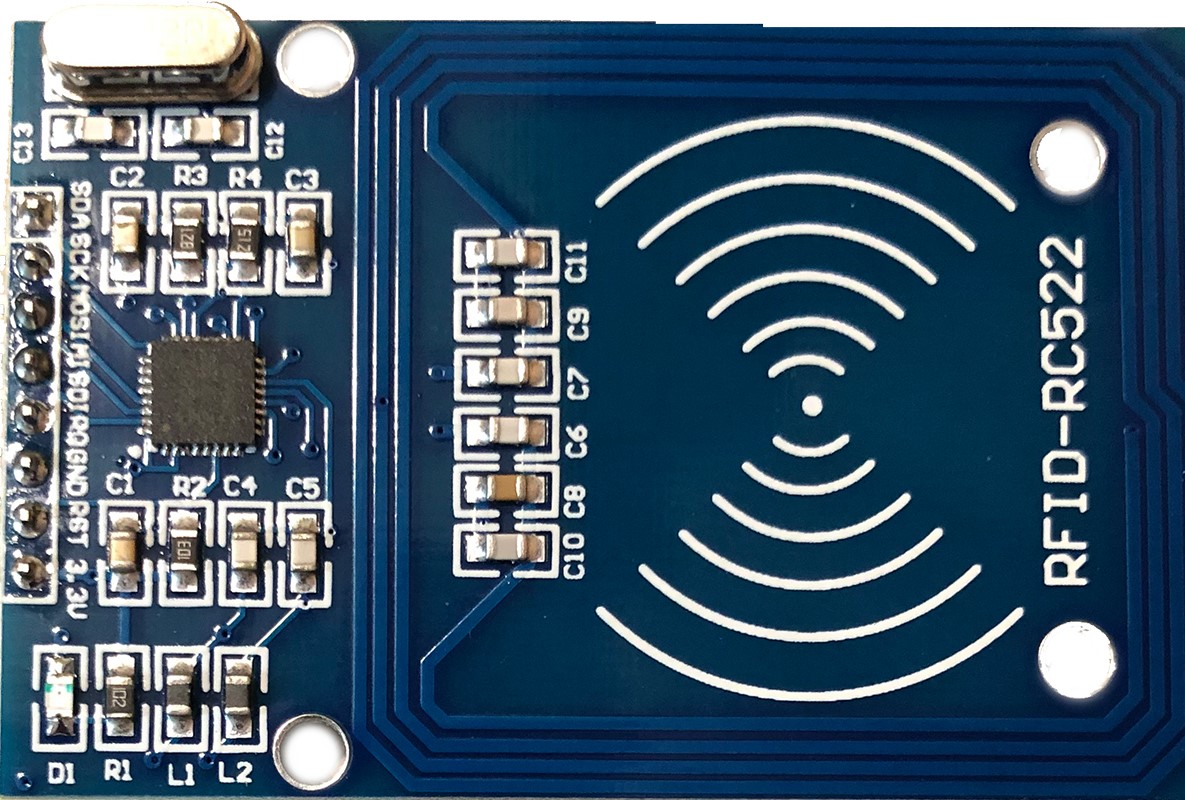RFID (Radio Frequency ID Scanner )
RFID - Radio Frequency ID

Radio Frequency ID
- Wireless technology identify devices
- RFID tags can be embedded in objects
- Can be passive (no power needed) or active (power/battery needed)
- RFID readers send a electromagnetic pulse (radio frequency), which triggers the tag to emit a response
RFID Uses
- Inventory tracking
- items, clothing, parts for manufacturing
- Access and identification
- hotel key cards
- ID cards (USC Card has an RFID tag)
- Contact-less payment
- ApplePay uses NFC (near-field communication), which is a form of RFID
RFID Sensor
- Sensors are designed to read cards are specific frequencies.
- Ours works at 13.56MHz
- RFID sensors and cards must all use the same frequency
- Sensor communicates with Photon 2 using SPI
- Operates at 3.3v
RFID Cards and Fobs

- Each key card and key fob have a unique code stored in their RFID tag (e.g.
OB 45 EA 0E)
Sensor Wiring (SPI)
| Sensor | Photon 2 |
|---|---|
| 3.3v | 3.3v |
| Reset | Any digital output pin |
| GND | GND |
| IRQ | - |
| MOSI | MO |
| MISO | MI |
| SCK | SCK |
| SDA | Any digital output pin |
RFID Library
MFRC522is a Photon 2 compatible library
Sample Code #1: Find the Card ID
- The following code is adapted from the library example
- Swiping key card in front of sensor will display the unique ID from each card
- Once the card’s unique ID is known, that ID can be used for tracking or identification (copy it from Serial monitor)
Sample Code #1: Setup
#include <MFRC522.h>
const int SS_PIN = A0;
const int RST_PIN = A1;
MFRC522 mfrc522(SS_PIN, RST_PIN); // Create MFRC522 instance.
void setup() {
Serial.println(9600);
mfrc522.setSPIConfig();
mfrc522.PCD_Init(); // Init MFRC522 card
Serial.println("Scan PICC to see UID and type...");
}
Sample Code #1: Testing and Resting
void loop() {
// Look for new cards (exit if no card is found)
if (!mfrc522.PICC_IsNewCardPresent()) {
return;
}
// Select one of the cards
if (!mfrc522.PICC_ReadCardSerial()) {
return;
}
// Dump info about the card. PICC_HaltA() is automatically called.
mfrc522.PICC_DumpToSerial(&(mfrc522.uid));
}
Sample Code #2: Checking for Authorization
- Once you have the unique for one or more cards, that ID can then be used to provide authorized access
- Based on the card that is present, different outputs can be enable (e.g. doors unlocked)
- To proceed, you will need the unique ID form a card which will be something like
OB 45 EA 0E
Sample Code #2: Setup
#include <MFRC522.h>
const int SS_PIN = A0;
const int RST_PIN = A1;
const String MATCH_ID = "OB 45 EA 0E"; //target id to match
MFRC522 mfrc522(SS_PIN, RST_PIN); // Create MFRC522 instance.
void setup() {
Serial.begin(9600);
mfrc522.setSPIConfig();
mfrc522.PCD_Init(); // Init MFRC522 card
}
Sample Code #2: Match ID
String scanId = "";
if (mfrc522.PICC_IsNewCardPresent()) { // check sensor
if (mfrc522.PICC_ReadCardSerial()) { // check valid read
for (byte i = 0; i < mfrc522.uid.size; i++) {
scanId += String(mfrc522.uid.uidByte[i] < 0x10 ? " 0" : " "); scanId += String(mfrc522.uid.uidByte[i], HEX);
}
scanId.toUpperCase(); //scanId will be lowercase
scanId.trim(); //scanId has an intial leading " "
//now we can check for a match!
if (scanId == MATCH_ID) {
//we found a match!
}
}
}
Sample Code #2: Match ID Explained
- The ID is 4 bytes long and is read 1 byte at a time
- This code from the library assembles the ID into a String in hexadecimal
if (mfrc522.PICC_IsNewCardPresent()) { // check sensor
if (mfrc522.PICC_ReadCardSerial()) { // check valid read
for (byte i = 0; i < mfrc522.uid.size; i++) {
scanId += String(mfrc522.uid.uidByte[i] < 0x10 ? " 0" : " "); scanId += String(mfrc522.uid.uidByte[i], HEX);
}
Sample Code #2: Match ID Explained
scanIdwill be stored in lowercase with a leading space- Ex: ` Ob 45 ea 0e` (* here is represents a space*)
- Since our
MATCH_IDis upper case with no leading space, we modifyscanId
scanId.toUpperCase(); //scanId will be lowercase
scanId.trim(); //scanId has an intial leading " "
Wiring
| Sensor | Photon 2 |
|---|---|
| 3.3v | 3.3v |
| Reset | A1 (any GPIO pin works) |
| GND | GND |
| IRQ | - |
| MOSI | MO |
| MISO | MI |
| SCK | SCK |
| SDA | A0 (any GPIO pin works) |
Diagram

Exercise
- Connect RFID
- Obtain IDs of two cards
- Create program to turn D7 LED on with one card and off with second card
- Use a
millis()timer to pause 1 second between each card read